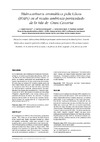Please use this identifier to cite or link to this item:
https://accedacris.ulpgc.es/jspui/handle/10553/72742
| Title: | Hidrocarburos aromáticos policíclicos (HAPs) en el medio ambiente particulado de la isla de Gran Canaria | Other Titles: | Polycyclic aromatic hydrocarbons (PAHs) in particulate environment of the island of Gran Canaria | Authors: | Lopez Cancio, J. Santana Rodríguez, José Juan Liminana Canal, J. Santana Aleman,Pedro Juan |
UNESCO Clasification: | 3303 ingeniería y tecnología químicas 230602 Hidrocarburos aromáticos 3308 Ingeniería y tecnología del medio ambiente |
Keywords: | Toxic equivalency factors Ambient air Urban air Atmospheric-environment Gas-chromatography, et al |
Issue Date: | 2009 | Journal: | Afinidad | Abstract: | An investigation on PAHs in the atmospheric particulate matter, TSP, of the city of Las Palmas de Gran Canaria (Gran Canaria isle, Spain) has been carried out. Urban atmospheric particulate matter was sampled in two sampling sites, whose characteristics were representative of the prevailing conditions. In each site 50 samples were performed from March 2002 to March 2003. PAH samples were collected on glass fiber filters extracted with dichloromethane with ultrasonication. Concentration levels and seasonal variations of 12 polycyclic aromatic hydrocarbons were determined. Calculated ratios B(a)P/B(ghi)P, and B(ghi)P/B(e)P indicates mainly traffic emissions. The hazard potential of PAH in terms of carcinogenicity is low. Potential risk on the basis of TEFs is also studied. Se ha efectuado una investigación sobre los HAPs presentes en la materia particulada atmosférica, MST, de Las Palmas de Gran Canaria (isla de Gran Canaria, España). La materia particulada fue muestreada en dos lugares representativos de las condiciones dominantes. En cada lugar se tomaron 50 muestras desde marzo de 2002 hasta marzo de 2003. Las muestras para HAPs se recogieron sobre filtros de fibra de vidrio y extraídas con diclorometano mediante ultrasonicación. Se establecieron los niveles de concentración y variación estacional de 12 HAPs. Se calcularon también las ratios B(a) P/B(ghi)P, y B(ghi)P/B(e)P y sus valores indican principalmente emisiones de tráfico de vehículos. El peligro potencial de los HAPs en términos de carácter cance- rígeno es bajo. Se estudia además el riesgo potencial sobre la base de los FETs. |
URI: | https://accedacris.ulpgc.es/handle/10553/72742 | ISSN: | 0001-9704 | Source: | Afinidad [ISSN 0001-9704], v. 66 (544), p. 445-453 |
| Appears in Collections: | Artículos |
Page view(s)
136
checked on Mar 15, 2025
Download(s)
106
checked on Mar 15, 2025
Google ScholarTM
Check
Share
Export metadata
Items in accedaCRIS are protected by copyright, with all rights reserved, unless otherwise indicated.
